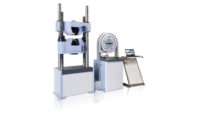
The mechanical impedance analysis (MIA) mode is particularly useful in the detecting or sizing of unbonds at the bond/unbond interface. Source: NDT Systems
Adhesive-bonded components and structures have become an important part of manufacturing, not only in the aerospace industry, but also in the automotive, wood-based panel and marine industries. Quality, reliable bonds are extremely important to the integrity of composite structures throughout their service life.
The wide range of materials and configurations used in multilayered structures and the need for nondestructive evaluation of bonds has resulted in many different types of testing equipment and methods being used.
Bond testers are well suited to inspecting metallic, nonmetallic and combination metallic-nonmetallic structures for a variety of anomalous conditions. These include measurable levels of unbonds, voids, delaminations, inclusions, porosity, fiber damage, core damage, bondline thickness variations and certain material properties. Inspectable configurations include adhesively bonded laminates, advanced fiber composites and honeycombs.
Some typical applications include multilayered laminates, Boron fiber composites, glass fiber composites, composite-to-composite, skin-to-honeycomb, impact damage, graphite-resin composites, Kevlar composites, composite-to-substrate, honeycomb structures, honeycomb-to-honeycomb and rub strip.
Multimode Bond Testers
A variety of models are tailored to the specific level of inspection required. Multimode ultrasonic bond testers offer modes including resonance, pitch-catch (fixed and swept) and a high-energy mechanical impedance analysis mode. Coupled with unique presentation modes, such as ultrasonic radio frequency (RF), phase/amplitude swept frequency and bond profile, the instruments can provide operators with the easiest methods of interpretation of inspection results available today.Reference Samples
In order to use bond testers, or any ultrasonic instruments for that matter, reference samples and standards are essential. At the very least, the operator should have a clear understanding of what is expected to be a good area on the part under test and compare this area with an area that is suspected to be bad. Bond testing is a comparative test.Reference samples or standards can be anything from specifically designed standards to samples acquired from known representative sources. Bond testers operate on a principle similar to sonar, operating in frequency ranges of 1 kilohertz to 1 megahertz.

By nulling out the good bond signal, the phase- and amplitude-vector end points of a disbond are compared to the good bond on an impedance-plane coordinate display. Source: NDT Systems
Pitch-Catch Test Mode
The pitch-catch mode is very easy in terms of calibration and requires no couplant.One element transmits (pitches) a burst of acoustic energy into the test part and a separate element receives (catches) the sound propagated across the test piece as shown.
The sound waves are propagated in a plate-wave mode across the test piece between the two probe tips. The return signals are detected and a phase-amplitude display is used to show the effect of good and bad bonds on the sound path.
MIA Mode
The mechanical impedance analysis (MIA) inspection method uses a single-tipped, dual-element probe. The drive element, coupled to the test piece through a plastic cone and wear shoe, generates audible sound waves into the test part.When the drive and receive elements are nulled, they vibrate together at the same phase and amplitude. When the probe is placed on a structure, the receiving element is affected by the sample stiffness, which varies from bonded to unbonded conditions. This change is monitored as a comparison between the drive and receive phase and amplitude signals.
The MIA mode is particularly useful in the detecting or sizing of unbonds at the bond/unbond interface.

Bond testers operate on a principal similar to sonar, operating in frequency ranges of 1 kilohertz to 1 megahertz. Source: NDT Systems
Resonance Mode
The resonance mode is typically performed by inducing a continuous wave, fixed frequency to a very narrow banded probe or sensor head. When the probe is coupled to the sample under test, the acoustic impedance changes within the material (due to unbonds) loads the probe in a manner that affect its resonant frequency and amplitude.By nulling out the good bond signal, the phase- and amplitude-vector end points of a disbond are compared to the good bond on an impedance-plane coordinate display. The phase resonance is generally used for detecting skin-to-skin disbonds such as with aircraft lap joints. This mode also works well for disbonds and delaminated materials. In many cases the depth of delaminations can be estimated using the signal-phase rotation. This method requires a coupling medium be used. A coupling medium is a substance such as water, oil, grease or paste used to avoid the retarding of sound transmission by air between the transducer and the test piece during ultrasonic examination

